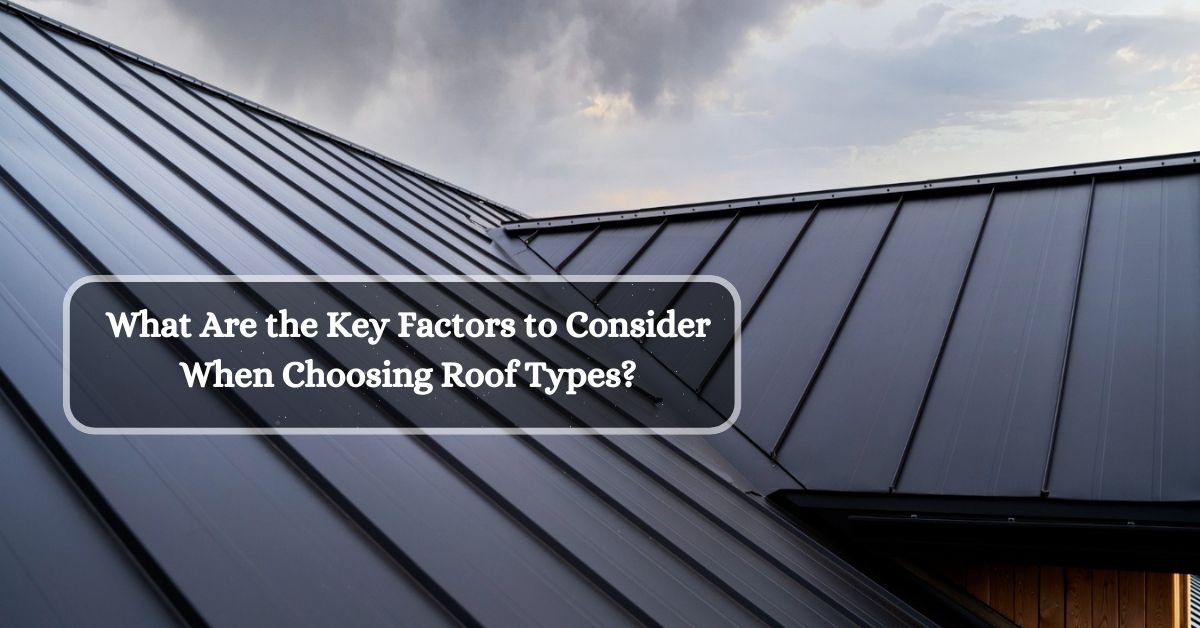What Are the Key Factors to Consider When Choosing Roof Types?

Roof installation is an expensive and significant decision that must be taken meticulously and carefully! Aside from merely a construction element, your roof is vital in safeguarding your family and possessions from harsh weather conditions! Thus, your home’s security and functionality depend substantially on the roofing material you choose.
However, with so many roofing alternatives available on the market, choosing the ideal roofing material might be daunting! When selecting the appropriate roofing type for your home, avoid deciding only on aesthetics since there are varied factors to consider, ensuring you’ve made a well-informed choice. Let’s delve in to explore!
Factors to Consider When Choosing Roof Types
● Local Weather Conditions
Your local conditions dramatically contribute to your roof type’s selection, as some roofing materials may be more compatible with your region’s climate than others. On the contrary, others may react differently to varying weather patterns, inhibiting their performance and durability in the long run.
Moreover, excessive water exposure may swiftly damage some roof materials, inflicting leaks in your house and leading to costly repairs. Therefore, it’s prudent to consult a certified roofing company in Redding to help you determine the best roof types considering your local climate, preventing future roof woes.
● Home Design
Contemplate your house’s overall aesthetics when deciding the roofing type for a new roof. Ensure your selected roofing style complements your house’s curb appeal. If you have a conventional-style home, utilize traditional materials like metal roofing. A built-up roof, often made of metal, may be required for commercial buildings. Additionally, weigh your roof’s slope since some materials drain better than others. It’s also one of the major decisive factors that help you facilitate your search.
● Cost
Defining your budget is another step that helps you narrow down your alternatives. Remember, expensive costs don’t imply superior quality. Hence, seek assistance from family, relatives, acquaintances, and roofing experts to make a sound decision. Before beginning the roofing task, estimate all your roofing expenses, such as labor costs, permit fees, any emergency or unforeseen modifications, and roof material costs. A sufficient budget is vital for roof installation, as it’s a back-breaking investment that must last as long as possible.
● Energy Efficiency
Your roofing material directly influences your house’s energy efficiency. The appropriate roof will spare you money on energy expenses. For instance, asphalt shingles and heavy metals efficiently reflect solar rays from your top, keeping your living roof cool and comfy as heat isn’t absorbed and transported below the ceiling. Consequently, you will experience a drop in your electricity bills due to the less use of air conditioners during summer to keep the house cool.
● Maintenance
Since investing in a roof is a long-term commitment, considering the selected roof’s maintenance is indispensable. Despite its high cost, certain roof types may necessitate little or no upkeep in the future. When choosing the roof types, take into account “how often you will need regular maintenance,” “the cost of professional maintenance,” and “Will it need multiple repairs or inspections.” Examine the time and effort required to keep the roof in pristine shape.
Also Read: Top Signs Your Roof Needs Maintenance and How to Address Them
● Roof Longevity
Depending on the material, the roof’s lifespan may vary. If you plan to live in your house for a prolonged time, roof materials with a long lifespan would be best. However, while particular materials, like metal, have expensive upfront costs and installation, they will last longer owing to their incredible durability and resistance to wear and tear. Therefore, choose the roofing material prudently so you won’t regret the decision later.
● Weight
Examine the roof’s weight since heavier roofing materials may compromise its structural integrity. Alternatively, leverage materials that complement, rather than overburden, the structural stability of your house. As buildings lose strength with age, choosing a lightweight roofing material like asphalt is critical to lessen the overall strain on the structure, eventually increasing the lifespan of your roof.
